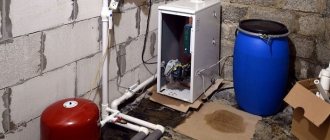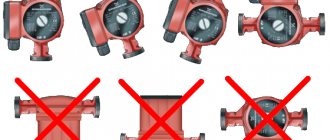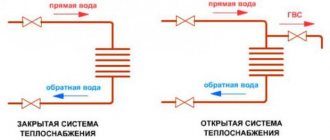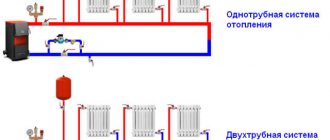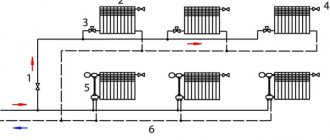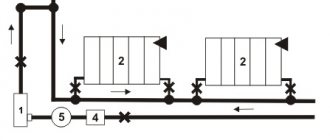Mixing ratio values
Design temperature in the heating network, ° С
Design temperature in the heating system, ° С
Normal operation of the elevator occurs at H / h = 8-12 (H is the available head at the inlet; h is the resistance of the heating system).
It should be borne in mind that the value of the design head in front of the elevator is directly proportional to the resistance of the heating system. Therefore, an increase in the resistance of the heating system, for example, by 1.5 times will cause an increase in the design pressure R also by 1.5 times.
Connection with a pump on the jumper (c). In the event that water mixing cannot be performed using an elevator, a pump is installed on the jumper between the supply and return pipelines of the heating system. Mixing with the help of an elevator cannot be performed for the following reasons: the head at the connection point is insufficient for its normal operation; the required thermal power of the mixing unit is large and goes beyond the capacity of the manufactured elevators (usually more than 0.8 MW - 0.7 Gcal / h).
When installing mixing pumps in residential and public buildings, it is recommended to use a silent, foundationless pump. When installing mixing pumps designed for high flow, centrifugal type K and KM are used as mixing pumps. The pump flow is equal to G2 = 1.1G1, and the head should be equal to H = 1.15h (where h is the resistance of the heating system).
Connection with a pump on the supply pipe of the heating system (d). A pump on the supply line is installed if, along with mixing water, it is necessary to increase the pressure in the supply line at the point of connection of the heating system (the static height of the heating system is higher than the pressure in the supply line at the point of connection).
The pump flow is equal to G3 = 1.1 (1 + U) G1, and the head should be equal to:
where h is the resistance of the heating system; hn is the difference between the static height of the heating system and the piezometric height in the supply pipe of the heating network at the point of connection, m.
Connection with a pump on the return pipe of the heating system (e). A pump on the return pipe is installed if, along with mixing the water, it is necessary to reduce the pressure in the return pipe at the connection point of the heating system (the pressure is higher than the allowable pressure for the heating system). The pump flow in this case is equal to C3 = 1.1 (1 + U) G1 and the head must have a value that provides the required pressure in the return pipeline.
Independent affiliation (e). If the pressure in the return pipe in the heating network is higher than the permissible pressure for the heating system, and the building has a significant height or is located at a high place in relation to adjacent buildings, then the heating system is connected according to an independent scheme.
According to an independent scheme, it is allowed to connect buildings with a height of 12 floors or more. The independent scheme is based on the separation of the heating system from the heating network using a heat exchanger, as a result of which the pressure in the heating network cannot be transferred to the heating medium of the heating system. The circulation of the coolant is carried out using circulation pumps of the K and KM types. The pump flow is determined by the formula
where Q is the power of the heating system, kJ / h (Gcal / h); C is the heat capacity of water, J / (kg · h); T11, T22 - design water temperature, respectively, in the supply and return pipelines of the heating system, ° С
It happens that private houses located within the city are located next to the laid central heating networks, and some are even connected to them. Of course, at the present time, the priority is individual heating, and centralized heating is gradually becoming a thing of the past. But if the house is already connected to the network or there are problems with the autonomous system, then you need to use what is available. For joint operation of the heat source with consumers, a dependent and independent heating system is used. What they are, as well as the pros and cons of both schemes will be outlined in this material.
Heat supply scheme for the city of Chelyabinsk for the period up to 2034
NOTICE OF THE START OF UPDATING THE HEAT SUPPLY SCHEME FOR 2021
13.01.2020
In accordance with paragraphs 15 and 37 of the Requirements for the procedure for the development and approval of heat supply schemes, approved. By decree of the Government of the Russian Federation of 22.02.2012 No. 154, the Administration of the city of Chelyabinsk decided to update the heat supply scheme for the Chelyabinsk urban district for the period until 2034 for 2021.
At the same time, the Department of Housing and Communal Services of the Administration of the city of Chelyabinsk announces the acceptance of proposals from heat supply and heating network organizations and other persons to update the heat supply scheme.
The updated heat supply scheme for the city of Chelyabinsk for 2020 is posted below on the current page.
In order to timely and comprehensively consider proposals and the need to approve the updated scheme within the time frame established by the requirements of the legislation, it is recommended to send proposals on time until 03/01/2020.
Proposals for updating the heat supply scheme are accepted in writing at the Housing and Utilities Department at the address: Chelyabinsk, st. Vorovskogo, 5-a, reception; working hours: Mon - Thu from 8-30 to 17.30, Fri from 8.30 to 16.15, lunch from 12.00 to 12.45, Sat, Sun - closed; as well as to the e-mail address: Additional information can be obtained by phone: 8, contact person - Ryazanova Daria Dmitrievna, Deputy Head of the Department of Prospective Development.
INFORMATION on the location of the updated heat supply scheme of the city of Chelyabinsk until 2034 as of 2020
03.10.2019
By order of the Ministry of Energy of Russia dated September 20, 2019 No. 1010, an updated heat supply scheme for the city of Chelyabinsk for the period up to 2034 as of 2020 was approved.
The current heat supply scheme for the city of Chelyabinsk for 2020
In accordance with clause 13 of the Requirements for the procedure for the development and approval of heat supply schemes, approved by Decree of the Government of the Russian Federation No. 154 dated February 22, 2012, the heat supply scheme and updated heat supply schemes, upon approval of the new heat supply scheme, are subject to invalidation.
INFORMATION on the location of the updated heat supply scheme
the city of Chelyabinsk until 2034 as of 2020 (expired)
14.09.2018 due to technical problems on the website in the period from 08/31/2018 to 09/13/2018, the updated heat supply scheme for the city of Chelyabinsk was re-posted for the period up to 2034 as of 2020.
30.08.2018 By order of the Ministry of Energy of Russia dated 30.08.2018 No. 717, the updated heat supply scheme for the city of Chelyabinsk for the period up to 2034 as of 2019 was approved:
Heat supply scheme of the city of Chelyabinsk for 2020
Heat supply scheme for the city of Chelyabinsk until 2034 as of 2020 (no longer valid)
29.11.2017
The updated heat supply scheme for the city of Chelyabinsk for the period up to 2033 as of 2020, approved by order of the Ministry of Energy of the Russian Federation No. 1101 dated November 22, 2017 (invalid version since August 30, 2018):
Heat supply scheme of the city of Chelyabinsk for 2020
Announcement
In book 12 of the heat supply schemes of the Chelyabinsk urban district for 2020 until 2033, the following boiler houses are LLC Novosineglazovsky plant of building materials (034), MUP DRSU (035), LLC PetroPak (036), (037), Kirov - Elkina (038) erroneously assigned to the ETSO zone No. 03 MUP "ChKTS".
